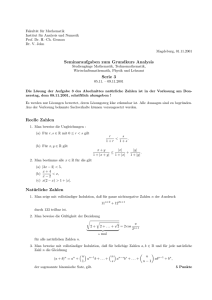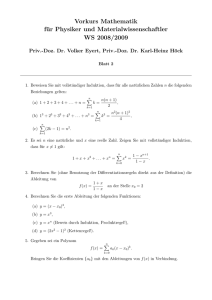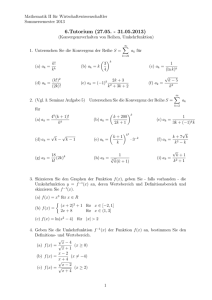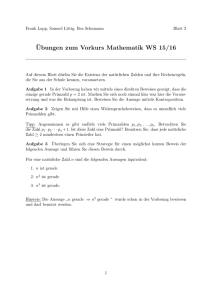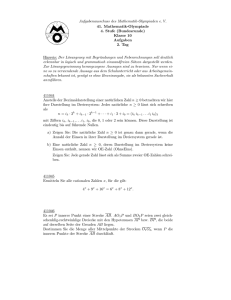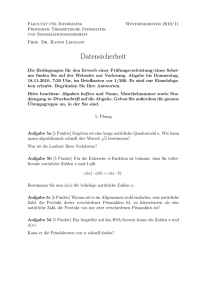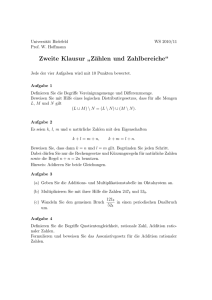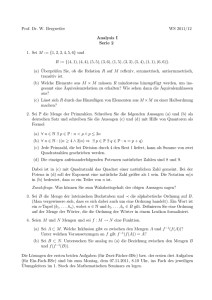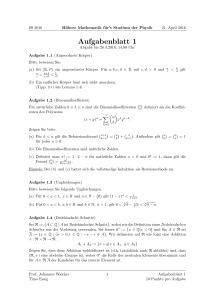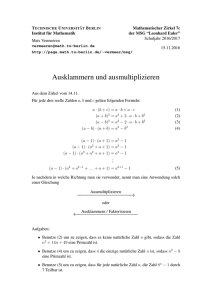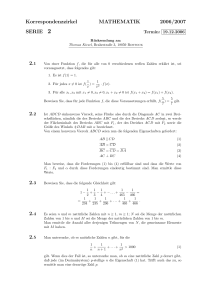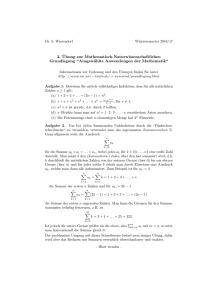Höhere Mathematik 1 Lösungshinweise zu den Hausaufgaben:
Werbung
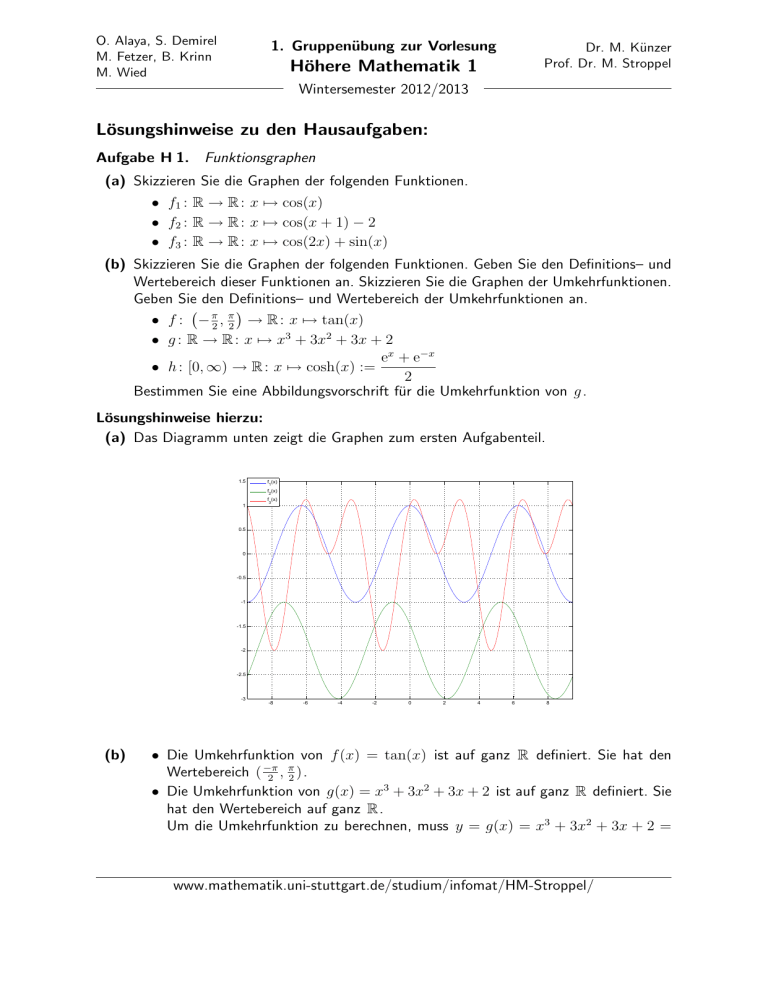
O. Alaya, S. Demirel
M. Fetzer, B. Krinn
M. Wied
1. Gruppenübung zur Vorlesung
Dr. M. Künzer
Prof. Dr. M. Stroppel
Höhere Mathematik 1
Wintersemester 2012/2013
Lösungshinweise zu den Hausaufgaben:
Aufgabe H 1. Funktionsgraphen
(a) Skizzieren Sie die Graphen der folgenden Funktionen.
• f1 : R → R : x 7→ cos(x)
• f2 : R → R : x →
7 cos(x + 1) − 2
• f3 : R → R : x →
7 cos(2x) + sin(x)
(b) Skizzieren Sie die Graphen der folgenden Funktionen. Geben Sie den Definitions– und
Wertebereich dieser Funktionen an. Skizzieren Sie die Graphen der Umkehrfunktionen.
Geben Sie den Definitions– und Wertebereich der Umkehrfunktionen an.
• f : − π2 , π2 → R : x 7→ tan(x)
• g : R → R : x 7→ x3 + 3x2 + 3x + 2
ex + e−x
• h : [0, ∞) → R : x 7→ cosh(x) :=
2
Bestimmen Sie eine Abbildungsvorschrift für die Umkehrfunktion von g .
Lösungshinweise hierzu:
(a) Das Diagramm unten zeigt die Graphen zum ersten Aufgabenteil.
1.5
f1(x)
f (x)
2
f (x)
1
3
0.5
0
-0.5
-1
-1.5
-2
-2.5
-3
(b)
-8
-6
-4
-2
0
2
4
6
8
• Die Umkehrfunktion von f (x) = tan(x) ist auf ganz R definiert. Sie hat den
Wertebereich ( −π
, π ).
2 2
• Die Umkehrfunktion von g(x) = x3 + 3x2 + 3x + 2 ist auf ganz R definiert. Sie
hat den Wertebereich auf ganz R.
Um die Umkehrfunktion zu berechnen, muss y = g(x) = x3 + 3x2 + 3x + 2 =
www.mathematik.uni-stuttgart.de/studium/infomat/HM-Stroppel/
1. Gruppenübung
Höhere Mathematik 1
(x + 1)3 + 1 nach x aufgelöst werden. Dies ist gleichbedeutend mit dem Auflösen
von y = (x + 1)3 + 1 nach x.
√
Die Umkehrabbildung ist damit g −1 : R → R : y 7→ 3 y − 1 − 1.
• Die Umkehrfunktion von cosh(x) ist auf [1, ∞) definiert. Sie hat den Wertebereich [1, ∞).
3
y=x
f(x)
f-1(x)
2
1
0
-1
-2
-3
-1.5
-1
-0.5
0
0.5
1
1.5
5
g(x)
y=x
4
g-1(x)
3
2
1
0
-1
-2
-3
-4
-5
-5
-4
-3
-2
-1
0
1
2
3
4
5
www.mathematik.uni-stuttgart.de/studium/infomat/HM-Stroppel/
1. Gruppenübung
Höhere Mathematik 1
15
h(x)
y=x
h-1(x)
10
5
0
2
4
6
8
10
12
14
Aufgabe H 2. Induktion
Zeigen Sie mit vollständiger Induktion:
n
X
(a) Für jede natürliche Zahl n gilt:
k · k! = (n + 1)! − 1
k=1
(b) Für alle natürlichen Zahlen k > 1 und alle positiven reellen Zahlen x1 , . . . , xk gilt:
(1 + x1 )(1 + x2 ) · · · (1 + xk ) > 1 + x1 + x2 + . . . + xk .
Lösungshinweise hierzu:
P
k · k! = 1 = 2! − 1.
IA Für n = 1 gilt
P
IH Es gelte
k · k! = (n + 1)! − 1.
IS Wir berechnen mit Hilfe der Induktionshypothese
1
(a)
k=1
n
k=1
n+1
X
k=1
k · k! =
n
X
k · k! + (n + 1) · (n + 1)!
k=1
= (n + 1)! − 1 + (n + 1) · (n + 1)!
= (n + 1)!(1 + (n + 1)) − 1 = (n + 2)! − 1.
(b)
IA Sei k = 2. Es gilt (1 + x )(1 + x ) = 1 + x
1
2
1
+ x2 + x1 x2 > 1 + x1 + x2 , da
x1 x2 als Produkt zweier positiver Zahlen positiv ist.
www.mathematik.uni-stuttgart.de/studium/infomat/HM-Stroppel/
1. Gruppenübung
Höhere Mathematik 1
IH Es gelte nun für eine natürliche Zahl k , dass (1 + x )(1 + x ) · · · (1 + x ) >
1 + x + x + · · · + x ist.
IS Wir berechnen
1
1
2
2
k
k
(1 + x1 )(1 + x2 ) · · · (1 + xk )(1 + xk+1 )
> (1 + x1 + x2 + · · · + xk )(1 + xk+1 )
= 1 + x1 + x2 + · · · + xk + xk+1 + x1 xk+1 + · · · + xk xk+1
> 1 + x1 + x2 + · · · + xk + xk+1 ,
da alle Produkte xi xk+1 als Produkt zweier positiver Zahlen positiv sind.
Aufgabe H 3. Induktion
2
(a) Zeigen Sie: Für jede natürliche Zahl n ist n3 + n2 +
(b) Die Fibonacci-Zahlen sind rekursiv definiert durch
n3
6
eine ganze Zahl.
f1 := 1, f2 := 1 und fn+1 := fn + fn−1
für n = 2.
Zeigen Sie mit vollständiger Induktion, dass für n = 2 gilt:
fn+1 fn−1 − fn2 = (−1)n .
Lösungshinweise hierzu:
(a)
IA Für n = 1 gilt, dass + + = 1 eine natürliche Zahl ist.
IH Es sei + +
eine ganze Zahl.
IS Wir berechnen
1
2
n2
2
n
3
1
3
1
6
n3
6
n + 1 (n + 1)2 (n + 1)3
n + 1 n2 + 2n + 1 n3 + 3n2 + 3n + 1
+
+
=
+
+
3
2
6
3
2
6
2n 3n2 + 3n
n n2 n3
+1 +
+
+
+
.
=
2
6}
2
6
|3
{z
|{z}
∈Z nach
IH
∈Z
2
Der Ausdruck 3n 6+3n lässt sich vereinfachen zu n(n+1)
, was für alle natürlichen Zahlen
2
n eine ganze Zahl ergibt, denn falls n gerade ist, so ist n durch 2 teilbar; ist n
hingegen ungerade, so ist n + 1 gerade und somit durch 2 teilbar.
(b)
IA Sei n = 2: Es gilt f = 1 + 1 = 2 und damit f f − f = 2 − 1 = (−1) .
IH Für n sei f f
− f = (−1) .
IS Wir benutzen im Folgenden die Rekursionsvorschrift der Fibonacci-Zahlen.
3
n+1 n−1
3 1
2
n
2
2
2
n
2
fn+2 fn −fn+1
= (fn+1 +fn )fn −fn+1 (fn +fn−1 ) = fn2 −fn+1 fn−1 = −(−1)n = (−1)n+1
www.mathematik.uni-stuttgart.de/studium/infomat/HM-Stroppel/
